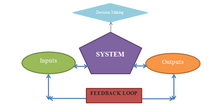This article has multiple issues. Please help improve it or discuss these issues on the talk page. (Learn how and when to remove these messages)
|
Regenerative design is about designing systems and solutions that work with or mimic the ways that natural ecosystems return energy from less usable forms to more usable forms.[1] Regenerative design uses systems thinking and other approaches to create resilient and equitable systems that integrate the needs of society and the well-being of nature. Regenerative design is an active topic of discussion in engineering, economics, medicine, landscape design, food systems, and urban design & community development generally.[2][3][4][5]
The regenerative design paradigm encourages designers to use systems thinking, applied permaculture design principles, and community development processes to design human and ecological systems. The development of regenerative design has been influenced by approaches found in biomimicry, biophilic design, net-positive design, ecological economics, circular economics, as well as social movements such as permaculture, transition and the new economy. Regenerative design can also refer to the process of designing systems such as restorative justice, rewilding and regenerative agriculture. In other words, regenerative refers to advances in Sustainable design since the 1990s, and the terms sustainable and regenerative are largely used interchangeably.

Regenerative design is increasingly being applied in such sectors as agriculture, architecture, community planning, cities, enterprises, economics and ecosystem regeneration.[6] These designers are using green or sustainable design principles observed in systems ecology and recognize that ecosystems that are resilient typically operate in closed loop systems. Using such models, regenerative design seeks feedback at every stage of the design process. Feedback loops are integral to regenerative systems[citation needed] as understood by processes used in restorative practice and community development.[citation needed]
Regenerative design is interconnected with the approaches of systems thinking and with New Economy movement. The 'new economy' considers that the current economic system needs to be restructured.[7] The theory is based on the assumption that people and the planet should come first, and that it is human well-being, not economic growth, which should be prioritized.
Whereas the weak definition of sustainable development was to satisfy fundamental human needs today without compromising the possibility of future generations to satisfy theirs,[8] the goal of sustainable design was to develop restorative systems that are beneficial for humans and other species. Sustainable design is participatory, iterative and individual to the community and environment it is applied to. It intends to revitalize communities, human and natural resources, and society as a whole.
In recent years regenerative design is made possible on a larger scale using open source socio- technical platforms and technological systems as used in SMART cities. It includes community and city development processes like gathering feedback, participatory governance, sortition and participatory budgeting.
- ^ Ikerd, John (2021). "The Realities of Regenerative Agriculture". Journal of Agriculture, Food Systems, and Community Development. 10 (2). doi:10.5304/jafscd.2021.102.001. S2CID 234037904.
- ^ Tillman Lyle, John (2017). Regenerative Design for Sustainable Development.
- ^ Melby, Pete; Cathcart, Thom (2002). Regenerative Design Techniques: Practical Applications in Landscape Design. John Wiley and Sons. ISBN 9780471414728.
- ^ Wahl, Daniel Christian (2016). Designing Regenerative Cultures. Triarchy Press. ISBN 9781909470798.
- ^ Loring, Philip (2022). "Regenerative Food Systems and the Conservation of Change". Agriculture and Human Values. 39 (2): 701–713. doi:10.1007/s10460-021-10282-2. PMC 8576312. PMID 34776604.
- ^ "Permaculture magazine". 2016-06-18. Retrieved 2018-11-27.
- ^ Diebold, William; Alperovitz, Gar; Faux, Jeff (1984). "Rebuilding America: A Blueprint for the New Economy". Foreign Affairs. 63 (1): 190. doi:10.2307/20042109. ISSN 0015-7120. JSTOR 20042109.
- ^ Brundtland, Gro Harlem (1991), "Our common future", Earth and Us, Elsevier, pp. 29–31, doi:10.1016/b978-0-7506-1049-0.50009-5, ISBN 978-0-7506-1049-0, retrieved 2024-05-08